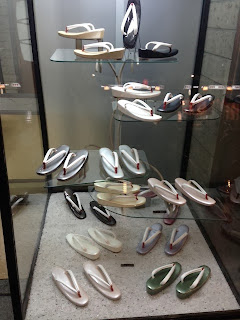Tanuki statues are all over the town of Shigarashi are of an actual species - a raccoon dog. TheTanuki have been deified and represent good luck, steadiness, virtue, financial luck and are considered magical, having the ability to change form, as in a shapeshifter….They are made in this town, and if you drove through the center of it you would think this along with planters that would be all that is made here.
These Tanukis are also everywhere in Japan, comparable with the cat waving its paw….(but in my humble opinion, not as cute)
Well there is a lot more going on here than mass production of Tanukis. Shigarashi and Bizen are pottery towns. In Bizen there are at least 400 kilns operating (that's wood burning not electric, think foundry not household ovens) at any given time.Why? These places are ancient kiln sites, 2 of the original 6 sites some that go back to the 13th century. But before I start talking too much about history, I know too little of, look at Robert Yellin's site: http://www.e-yakimono.net/guide/
This will give you the full story with images from a very knowledgeable source.
Meanwhile, we visited 2 artists studios Kanzaki Shiho whose work is very beautiful and primordial.
Then we went to the light and airy home and studio of Kohyama Yasuhisa.
Gallery shot above, Kiln shot below.
I really liked the work, and the work of his wife/partner, Wakae (more folk craft style or mingei) that we had green tea cake and cookies on (yum) were wonderful as well.
Bizen is a beautiful pottery town. A pottery town was established long time ago and is considered one of the 6 original (ancient) kiln sites. The number has grown as archeological digs have found evidence of other sites. Meanwhile Bizen is picturesque, unlike the main areas of Shigarashi. Though trying to find a quick lunch was not simple as all the commercial that are not sit down restaurants or pottery galleries are on the edges. Kind of like those charming little destination towns in Connecticut where one goes 'antiquing'. Though this is Japan and it's pottery. Kind of the same, but mostly different. Sigh. I'll let the pix doing the describing. Again, I highly recommend the Robert Yellin site to get the real 411 on this. www.e-yakimono.net
We went to visit the home and studio of Isezaki Jun, the living treasure of Japan for ceramics. Another parallel would be a national MacArthur grant. The honor of being a national treasure is more governmental: one must be elected and one must lecture on their craft to support interest in it and it is more of the classic style of pottery (or whatever discipline) than the personal. It's complex and deep, as these things. I don't know enough to speak with authority, I'm attempting to give a parallel for understanding. None the less, he is a master of his craft.
A partial view of Isezake Jun's studio.
A work in progress. This is more of his 'personal work' versus the classic tea bowl (chawan) or sake bottle (tokkuri) or cups (guinomi)
The small kiln with a bit of Kochiro (Jun's son). Interior of 40 foot kiln. It takes 2 weeks to load, 2 weeks to fire (see wood pile in small kiln photo) which is a 24/7 experience keeping the temperature consistent and draft moving and adding ash as needed. This is a very very simplistic explanation of the firing process. This kiln is part of the Isezaki compound, it has only been fired once, thus it's pristine condition. If you plan on building one of these this would be a good model to follow.
A partial view (still life) of the garden of Kokurezaki Kyuichi.
Kokurezaki's outdoor studio near the kiln. He was referred to as a 'rock star potter'. Such a person exists in Japan. When we visited his home and studio, he was preparing for a solo show in one of the major museums in Japan.






















































